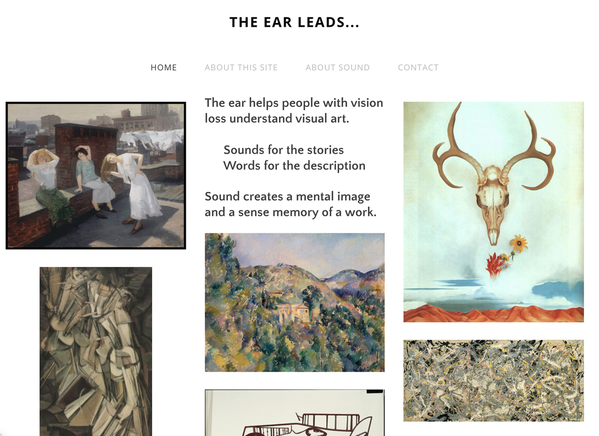Writing AD with Sound
When a sighted person experiences a work of art, he/she can be left with a visual memory of the work and with a sense memory of the experience. For people with vision loss, Audio Description -- combined with sound -- can help do the same. Creative use of sound --- music, sound effects, ambiences, dialogue -- can help listeners have a richer sensory experience, help them understand how a work looks, and leave them with a visceral sense memory of the art. Here are different approaches I have taken in combining AD with sound.
1. BACKGROUND AMBIENCE AND SOUND EFFECTS
Adding a few simple audio elements can support a feeling suggested by a work and also help the listener to visualize.
(Egs. birds in a forest setting, restaurant ambience, horses trotting on cobblestones, a church bell tolling in the distance.
The content of the work and imagination suggest the ambience). An example: an inclusive museum tour stop of a painting by Paul Cezanne titled View of the Domaine St. Joseph. It is 3 minutes long. You can read a transcript here.
1. BACKGROUND AMBIENCE AND SOUND EFFECTS
Adding a few simple audio elements can support a feeling suggested by a work and also help the listener to visualize.
(Egs. birds in a forest setting, restaurant ambience, horses trotting on cobblestones, a church bell tolling in the distance.
The content of the work and imagination suggest the ambience). An example: an inclusive museum tour stop of a painting by Paul Cezanne titled View of the Domaine St. Joseph. It is 3 minutes long. You can read a transcript here.
2. STORYTELLING WITH SOUND. THEN AUDIO DESCRIPTION
In this approach I combine music, sound effects, and dialogue with storytelling techniques to first introduce the historical or cultural context for a work. That is followed by a detailed Audio Description of the work. An example: an audio tour stop of a painting by Jackson Pollack titled Number 27. It is four minutes long. (Listen with headphones) You can read a transcript here.
In this approach I combine music, sound effects, and dialogue with storytelling techniques to first introduce the historical or cultural context for a work. That is followed by a detailed Audio Description of the work. An example: an audio tour stop of a painting by Jackson Pollack titled Number 27. It is four minutes long. (Listen with headphones) You can read a transcript here.
3. INTEGRATING SOUND WITH AUDIO DESCRIPTION
Sometimes I integrate the sound with narration and with Audio Description. This technique creates an inclusive listening experience for both people with sight and people with vision loss. An example: the painting Louisiana Rice Fields by Thomas Hart Benton. It is four and a half minutes long. (Listen with headphones). You can read the transcript here.
NOTE: You can find another example of integrating sound with Audio Description -- John Sloan’s painting Women Drying Their Hair – on this web site’s page Writing AD for Museums.
4. CREATING AUDIO ANALOGUES
Sometimes I have found or created sound analogues for visual images or artistic techniques. An example: The painting Nude Descending a Staircase by Marcel Duchamp. It is three minutes long. (Listen with headphones). You can read a transcript here.
Sometimes I have found or created sound analogues for visual images or artistic techniques. An example: The painting Nude Descending a Staircase by Marcel Duchamp. It is three minutes long. (Listen with headphones). You can read a transcript here.
